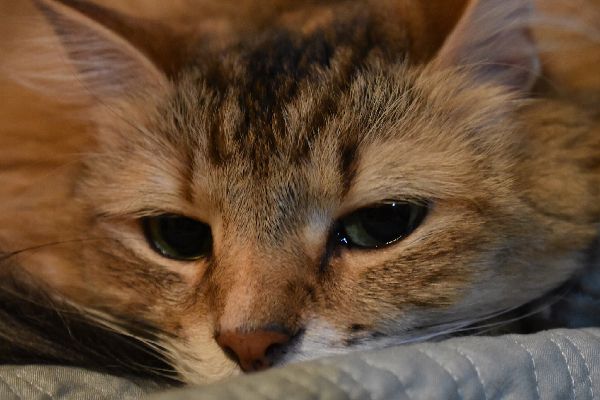If you wake up one morning and notice that one of your cat’s eyes looks a little odd, you might wonder if it’s something that requires a veterinary visit. What does it mean if your cat has watery eyes or teary eyes, or if your cat is squinting or pawing at her eye? We’ve got the scoop on how to handle watery cat eyes.

First, what causes watery cat eyes?
“A number of things could be causing your cat to experience excess tearing,” says Ari Zabell, DVM, Dipl. ABVP, director of client advocate support for Banfield Pet Hospital based in Vancouver, Washington. “Generally, it falls into two categories: things that block the normal flow of tears and things that produce excessive tears.”
According to Dr. Zabell, when things are functioning normally, tears from the eyes drain into the nose. “This is why your nose runs when you cry,” he says. “This flow could be blocked by a number of factors, such as inflammation, infection, swelling or simply the shape of your cat’s face. Excessive tears are usually produced by things that cause inflammation, for example, infections (bacterial, viral or fungal), allergies, or even something growing into the eye like a tumor or even just a hair.”
Other causes of watery cat eyes include a scratch or injury to the eye, or a foreign body stuck in the eye like a grass seed or tiny bit of something (just think of how much your own eye waters when you have an eyelash caught in between the eye and the lid).

Are some types of cats and cat breeds predisposed to have watery eyes?
Sometimes those watery cat eyes can be caused by the shape of the face and eyes. Brachycephalic cats (or flat-faced cats) often experience watery eyes. When a cat has a flat face, a small nose and large, round eyes, the tears tend to spill over the eye rims.
Some cats are also genetically predisposed to producing more tears than other cats. Watery cat eyes and the resulting tear stains (those unsightly brown streaks under the eyes) are common in cat breeds like Exotic Shorthairs, Himalayans and Persians, for instance. In general, this doesn’t harm the cat as long as nothing else is going on with the eye (always check with your vet to be sure), although you should regularly wipe the under-eye area to keep it as clean and dry as possible to prevent skin irritation.
When do watery eyes warrant a visit to the vet?
If your cat doesn’t generally have watery eyes, but you suddenly notice excessive tearing, visit the veterinarian to get to the bottom of things. This is true whether your cat’s eyes have a clear, watery discharge or a thicker, yellow- or green-colored eye discharge. Other symptoms of watery cat eyes that need vet attention include squinting or blinking, pawing or rubbing at the eye, red or inflamed eye tissue, a cloudy-looking eye, or discharge from the nose as well as the eye.
“There are a number of things your veterinarian can do to evaluate your cat’s eyes, including looking for damage to the structures of the eye (both inside and out), measuring the pressures inside the eye, and assessing the production of tears and the normal flow of those tears,” Dr. Zabell explains. “After they have determined what is and isn’t normal, they will be better able to determine what the underlying cause might be and work with you to develop a treatment plan, as necessary and appropriate.”
Treatment
If your cat is diagnosed with a condition that requires medication, your vet might send you home with some eye drops or ointment. Cats are not always the most compliant patients, but your veterinarian or a veterinary technician will show you how to successfully administer the medication before you leave the hospital.
“Some general rules include working in a calm and quiet area where your cat is less likely to be stressed or distracted; administering medication to your pet on a table instead of the floor; and rewarding your cats before, during and after the treatment, so they have positive associations with medication and won’t be quite as likely to hide under your bed before the next treatment,” Dr. Zabell advises.
When using eye drops or ointment, try not to touch the dropper or tip of the tube to the surface of your cat’s eye. Ointment might be easier to administer than drops, so ask your veterinarian about your options before leaving the appointment.
Thumbnail: Photography ©Maria Diana Gonzales | iStock/Getty Images Plus.
This piece was originally published in 2018.
